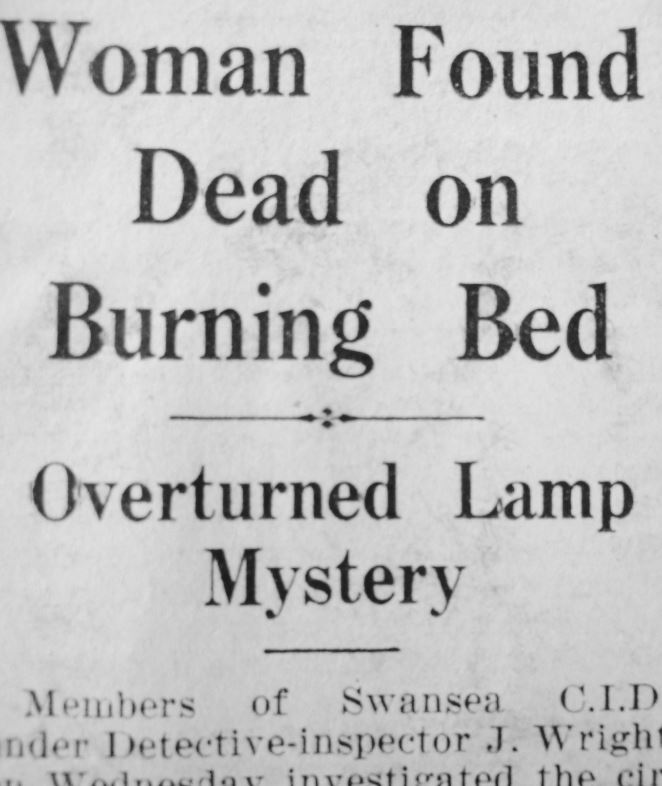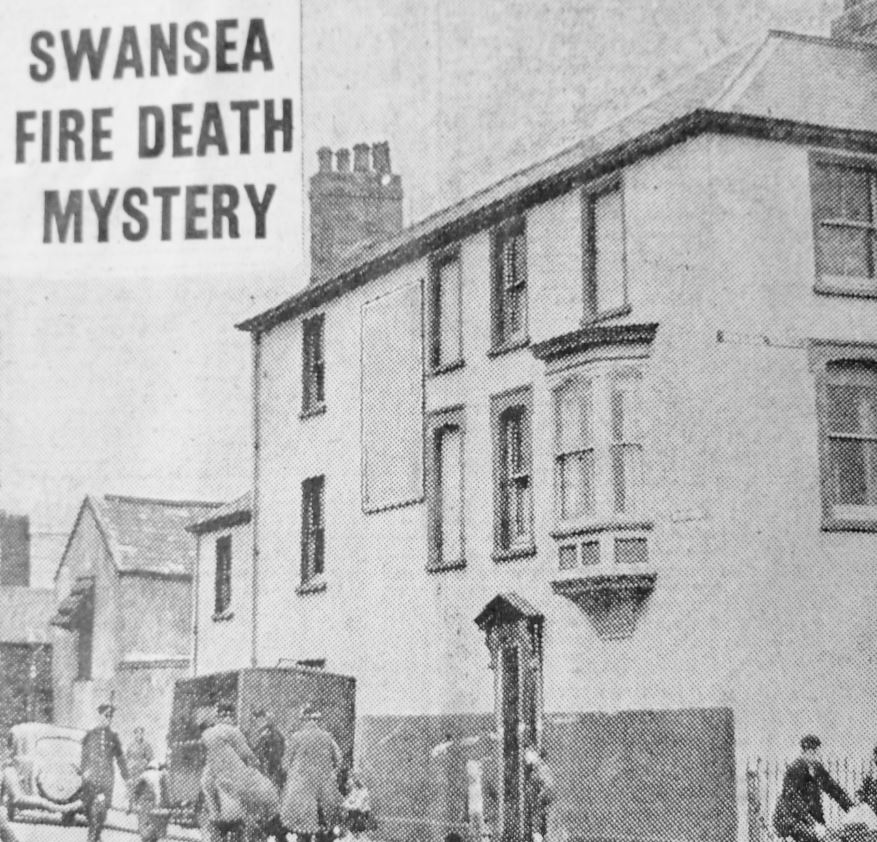The body was identified by William Richards. He confirmed that it was his mother in law, the wife of a labourer called William Webber. She might have been known to some as May Taylor but her name was Ruth Webber and she was 43 years old. She was living in a flat at 38 Trafalgar Terrace, on the corner with Beach Street. Her body was found by Mrs Hammond who took her an early morning cup of tea on 18 January 1939 and found the room full of smoke. It was not a pretty sight. Her legs and the lower part of her body had been burnt away. An oil lamp which it is assumed must have set fire to the clothes was overturned on the bed. Death was due to asphyxia and the shock brought on by extensive burns.
It was initially a simple, if gruesome, newspaper report in The South Wales Daily Post. But the police started to take an interest right from the start in the belief that the fire was just a feeble attempt to destroy evidence and the following week Allan Maclean a 26 year old seaman of no fixed abode was charged with her murder. They believed he had strangled her.
Maclean was a sailor from Greenock in Scotland and he had been discharged from the Fidra in the morning of 17 January 1939. He had gone first to the cinema and then drinking in various pubs until he had ended up in The Black Lion.
Ruth Webber had also gone out drinking, with her friend Mrs Olsen. They had been to the Rum Puncheon and had made their way finally to The Black Lion. There they met Maclean. They played darts and they drank. By 9.00 pm they were drinking cheap white wine in The Brooklands Hotel. They bought a flagon of beer and took it back to Trafalgar Terrace.
What happened next is hazy in places but that reflects the condition of the protagonists in this horrid little tale. Such are the consequences of cheap white wine. We can though piece together a version of what probably happened. It would seem that Ruth asked Maclean for 10 shillings which he promptly handed over. Ruth dimmed the light on the oil lamp and got into bed. He took his clothes off climbed into bed and as far as he was subsequently aware fell asleep. He woke suddenly to find himself staring at the wall. He turned over to find Ruth going through his pockets
He called her a dirty little thief and jumped out of bed. He pushed her over and she banged her head on the bed frame. He remembered blood on her face. She started screaming and swearing and fearful that someone would hear he clamped his hand over her mouth. Then she was lying on the bed, mumbling. He searched for his clothes. He might have used the lamp to find them. He put the bed clothes over her on the bed. He left. It was around midnight and too late to get a room in the Seaman’s Home so he slept in a bus shelter.
Of course the only one who could offer any explanation of what happened was Maclean and he obviously tried to present his actions in the best light that he could. He must have shown much more violence and aggression than he admitted in court as her injuries indicated. He admitted that he was there but he denied murder. Whatever happened had been a complete accident. He denied moving the lamp deliberately. If he’d known she was in danger he would not have left, though you may question whether he knew anything at all.
Ruth wasn’t dead when he left. There was carbon in her wind pipe that showed she had inhaled but she was so deeply unconscious that the pain of being burned alive didn’t wake her. There were no burns on her hands so she had not tried to bat out the flames. The oil lamp was amongst the bed linen and had set alight to the flock mattress. It had smouldered for about eight hours and Ruth Webber had slowly roasted or simply cooked to death.
Two residents, the Lewis brothers, answered Mrs Hammond’s screams and carried the body on to the landing, burning their hands in the process. It must have been an awful sight.
The fire had been clearly defined in the centre of the bed. Neither the clothes at the bottom nor the pillows at the top were touched.
The lower part of the torso was completely burned and as far as the legs were concerned there was nothing but a few bits of bone found amongst the bedding.
Her head injuries however were plain to see. There were extensive bruises on the face, lacerations over the left eye and haemorrhages to each side of the voice box.
The prosecution were convinced that he had used great violence on her. Webber and Maclen had certainly quarrelled and he had certainly been the last person to see her alive. He had hit her on the head with something – perhaps the oil lamp – and then strangled her to unconsciousness. There was an extensive bruise on the right lower jaw which extended down to the bone. She hadn’t been hit once, but several times. The question was how did the oil lamp end up on the bed? Was it accidental, a consequence of moving an untidy pile of bedding and clothes? Or had it been a deliberate attempt to destroy her to cover up the evidence of his attack? The oil lamp had been moved on to the bed. It hadn’t got there on its own. Only two people could have done it. And one was dead and one was facing possible hanging.
Maclean had given himself up to the police on the evening of 18 January 1939. He had been in the Commercial Inn in Landore where he read about the death in the newspaper. He said to David John the licensee
What have you got to worry about? I was with a woman last night and she was burnt to death
He telephoned the police and waited for them to collect him in a car. He pleaded not guilty to a charge of murder and throughout the trial believed himself to be guiltless. As far as he was concerned it was a consequence of an unfortunate drunken brawl.
The jury considered their verdict for an hour and found him not guilty of murder but guilty of manslaughter. He was sentenced to five years penal servitude. Mr Justice Cassels said that he showed callous disregard for the safety of the creature of whose body you were making use of.
He had previously been convicted of house breaking in 1935 and of assault in 1936. Ruth herself was well known to the police. She frequented public houses and had been convicted some years earlier. This was probably not for traffic offences. But this is irrelevant. As the judge said
However low the woman might have sunk, however sordid her mode of living, she was within the law and entitled to live.
This story features in my book Swansea Murders, along with 24 other unfortunate cases from our history. I have now received new stock. Go to the How to Buy page which you can find in the menu or by clicking on this link. Price includes delivery and recycled packaging.
If you want to find out more about Swansea Murders then there is a page about it, again you can find it in the menu or by clicking here.




Dear Mr. Brookes,
My new-found cousin drew my attention to this article for a very good reason. I’m sorry to say that my long-lost father who I never knew was Allan MacLean. There’s probably a proverb that warns against digging into the past, you don’t know what you are going to unearth. I was looking for closure, and in a sense I’ve gained that, but there is no silver lining concerning this man. My mother did pick ’em!
I found out that he died in 1974 in a London hospital with a fractured skull. The coroner delivered an open verdict.
If there is a picture of him it would be something.
Colin Markham
I grew up in this house, from birth to 13 yrs old. I can safely say that I don’t think Ruth’s spirit was rested. Too many odd things that happened to my family and others who rented the other flats there. I hope the current tenants aren’t too bothered or just live side by side with her.
There must be a memory imprinted in the walls and the bricks
Thank you for your interest in my work. It is greatly appreciated
Best wishes
Geoff